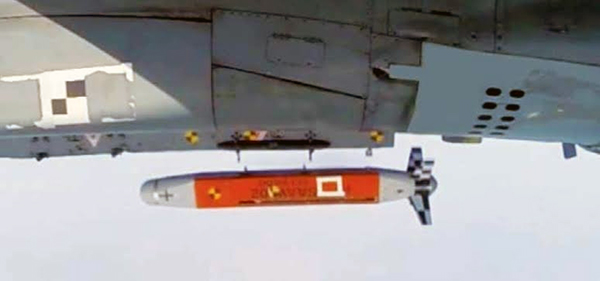SOURCE: IDRW.ORG


India’s Defence Research and Development Organisation (DRDO) has embarked on preparations to test an advanced iteration of its Smart Anti-Airfield Weapon (SAAW), marking a significant leap in precision-guided munitions technology. The next-generation SAAW, equipped with an Electro-Optical (EO) seeker, will now possess the capability to engage moving targets—a feature that broadens its operational scope beyond static infrastructure. Retaining its impressive 100-kilometer range, this upgraded variant promises to enhance India’s tactical strike capabilities, reinforcing its position as a leader in indigenous defense innovation.
The Smart Anti-Airfield Weapon, first tested in 2016, was designed as a lightweight, precision-guided bomb to neutralize enemy airfields, bunkers, and radar installations. Developed by DRDO’s Research Centre Imarat (RCI) in collaboration with the Indian Air Force (IAF), the baseline SAAW weighs approximately 125 kg and uses a satellite-based inertial navigation system (INS) augmented by GPS for guidance. Dropped from aircraft like the Jaguar, Su-30 MKI, and Hawk, it employs a high-explosive penetration warhead to crater runways or destroy fortified targets, rendering them inoperable.
The original SAAW, successfully tested in 2021 from a Hawk trainer at Pokhran, demonstrated pinpoint accuracy against static targets at ranges up to 100 km. Its integration with the IAF’s Rafale jets further underscored its versatility. However, the evolving nature of warfare—where adversaries increasingly rely on mobile assets like missile launchers, convoys, or command vehicles—necessitated an upgrade. Enter the EO seeker-equipped SAAW, a next-generation variant poised to meet these dynamic battlefield demands.
The addition of an Electro-Optical seeker represents a transformative upgrade for the SAAW. Unlike the earlier version’s reliance on pre-programmed coordinates and satellite navigation, the EO seeker integrates a high-resolution imaging system—typically infrared or visible-light cameras—enabling real-time target acquisition and tracking. This allows the weapon to lock onto and pursue moving targets, such as vehicles or personnel, even in contested environments where GPS signals might be jammed.
The EO seeker enhances the SAAW’s terminal guidance phase, offering a “fire-and-forget” capability. Once launched, the weapon can autonomously adjust its trajectory based on visual or thermal signatures, ensuring a higher probability of a direct hit. This upgrade aligns the SAAW with global standards, resembling systems like the U.S.’s Joint Direct Attack Munition-Extended Range (JDAM-ER) or Israel’s Spice bombs, but with a distinctly Indian design tailored for cost-effectiveness and local integration.
DRDO has ensured that the next-generation SAAW retains its 100-km range, a standout feature that allows launch aircraft to strike from standoff distances, minimizing exposure to enemy air defenses. The weapon’s aerodynamic design, featuring foldable wings, enables it to glide efficiently toward its target, conserving energy while maximizing reach. With the EO seeker, this range now applies to both static and mobile threats, making the SAAW a versatile tool for the IAF and potentially the Indian Navy’s carrier-based operations.
The ability to hit moving targets expands the SAAW’s mission profile significantly. Beyond its original role of disabling airfields—crucial in conflicts with adversaries like Pakistan or China—it can now neutralize mobile missile batteries, artillery units, or logistics convoys. This versatility is particularly relevant along the Line of Actual Control (LAC), where China’s deployment of mobile systems has heightened the need for adaptive strike options.
DRDO’s preparations for testing the EO-equipped SAAW signal that the weapon is nearing operational readiness. Sources indicate that the trials, likely scheduled for mid-2025 at ranges like Chandipur or Pokhran, will involve live drops from IAF platforms, including the Su-30 MKI and Rafale. These tests will evaluate the seeker’s performance under various conditions—day and night, adverse weather, and against simulated moving targets—to validate its accuracy and reliability.
The integration process builds on DRDO’s prior success with the SAAW. The agency has likely refined the weapon’s electronics and software to accommodate the EO seeker without compromising its lightweight design or range. Static tests of the seeker’s imaging and tracking systems have presumably been completed, paving the way for dynamic flight trials. Collaboration with the IAF ensures that the weapon aligns with operational doctrines, potentially setting the stage for rapid induction post-testing.
NOTE : Article cannot be reproduced without written permission of idrw.org in any form even for YouTube Videos to avoid Copy right strikes. Websites doing illegal reproductions will get DMCA and Legal Notices.